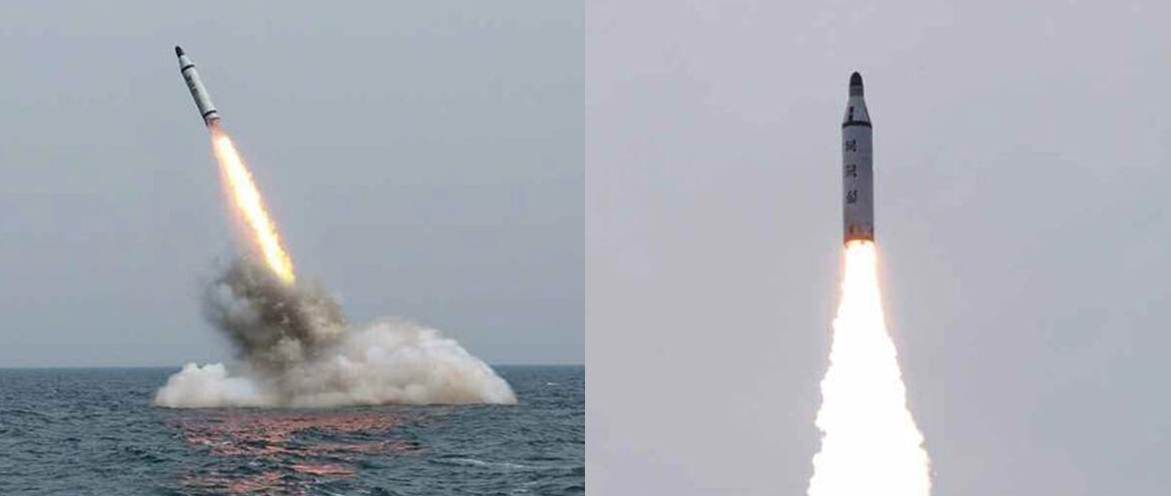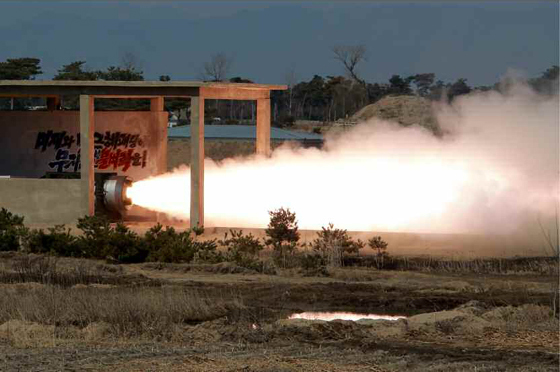A New Submarine-Launched Ballistic Missile for North Korea
Summary
North Korea has revealed images of a submarine-launched ballistic missile test indicating that it has abandoned the liquid-fuel design that has consistently failed in the past and switched to a more robust solid-propellant system that will have a better chance of actually working in an operational environment. The new design is still in the earliest stages of testing, and much work, including development of a full-scale motor, needs to be done. Nevertheless, the simpler design is likely to be less troublesome to develop and could be ready by 2020. The solid-propellant missile would have reduced performance, with a range of 900 km compared to 1600 km for a liquid-propellant version, but is still likely to meet North Korean requirement to pose a challenging threat to US allied defenses, primarily in Northeast Asia.
The New SLBM Test
On April 23, North Korea tested a submarine-launched ballistic missile (SLBM) for probably the fifth time and shown us pictures for the third time. They’re clearly learning from their mistakes. Unfortunately, part of what they are learning is to carefully frame the pictures they release so that we can’t be sure what they might have been hiding. The last time the North showed the world an SLBM test, it accidentally let slip a few frames of video that suggested the test was from a submerged barge rather than a submarine, and a few more showing that the missile had exploded shortly after launch. Pyongyang then made a clumsy cut to stock footage of a completely different missile flying into the heavens. This time, the pictures show what seems to have been a successful launch, but without enough detail to verify more than a few basic facts.
The US Strategic Command has confirmed that it detected a launch on April 23, with South Korean sources indicating that the missile had achieved a range of only 30 km. If all three governments say the missile was launched, we can conclude that a missile was launched. Almost certainly the US would detect and track such a launch by satellite, and it is possible that the South Korean Navy would have had a ship in place to track it by radar. But what are we to make of the short range?
In order to fly even 30 km, a ballistic missile has to not only launch successfully but accelerate well past the speed of sound. For a single-stage missile, those are the hard parts—once accomplished, the safe bet is that the missile will continue to accelerate until it runs out of fuel, and coast on a ballistic arc to its maximum range. There’s still the matter of arranging for the warhead to come down intact and close to the intended target, which isn’t trivial. But if the missile flew 30 km, there is a good chance it was only carrying fuel for 30 km. To be fair, after four failed test launches, one can understand the test crew not wanting to have a full 10 to 20 tons of rocket fuel falling on their heads, expensive barges or submarines.

Looking at the pictures we have, in last year’s test, the exhaust plume emerges from the nozzle in a narrow and almost translucent state that only 2 to 3 meters downstream develops into the classic yellow-orange streak of fire. The plume never expands much wider than the missile’s body, and dissipates about 20 meters downstream. This is a classic liquid-rocket plume, probably from an engine burning kerosene, and from the size, very likely North Korea’s Nodong engine.
The most recent test shows an almost incandescent white plume emerging fully-formed from the missile’s base, expanding significantly, and ultimately leaving a trail of light grey smoke. This looks like the same missile, but they clearly are not the same engines. It is very much like a classic solid rocket motor exhaust plume. And guess what? Just last month, North Korea showed the world a ground test of a solid-fuel rocket motor. Note the similar shape and color of the plume.

The motor from last month’s test, about 1.25 meters in diameter and 3 meters long, is too small for this missile. The KN-11 SLBM is 1.5 meters in diameter and a bit over 9 meters long, probably weighing almost 15 tonnes. This motor, as far as we know, the largest solid-fuel rocket motor North Korea has ever built, would probably get the KN-11 into the air, but it wouldn’t get it very far. A quick calculation suggests that such a combination would have a maximum range of about 30 km.
So why the switch, and what is the point of testing a missile with such a short range? To begin with, let’s note that the original configuration with the Nodong engine was perhaps the worst possible way to build an SLBM. It is what North Korea had when they began this program. If the North Koreans had kept at it, they would have probably found a way to make it work. The Russians, eventually made something similar work back in the 1960s, and we know the North Koreans hired some of the Russian engineers who did that. But liquid-fuel rockets and submarines are a bad mix, and the Nodong was never designed for that application.
In particular, when a missile is ejected from a submarine launch tube, any liquid propellant is going to slosh violently in the tanks, possibly with enough force to tumble the missile or rupture the tanks. And if the fuel inlet is uncovered for even an instant, the high-performance fuel pump of a typical liquid-fuel rocket will overspeed and destroy itself trying to suck air. Very likely, the rocket will explode shortly after igniting the engine. We have seen that at least once in the case of North Korea and it may have happened several other times we haven’t seen.
It is possible to overcome these challenges, as the Russians did with their R-27 submarine-launched ballistic missile. There is evidence that the North Koreans obtained this technology, and maybe even surplus missiles, from Russia. Earlier this month, the North displayed footage of a ground test of what appeared to be a pair of R-27 missile engines clustered together. And the R-27 missile was almost exactly the right size to fit in the launch tubes of North Korea’s GORAE-class missile submarine. So why not just use that missile the way it was meant to be used?
The obvious answer is that the last of those missiles were built over 30 years ago, and any that might have reached North Korea have probably endured some rough handling and careless storage along the way. While Pyongyang has never successfully flown a missile based on the R-27., there were reports of a failed launch earlier this month, which may have been a North Korean derivative called the Musudan. So, even if the North Koreans can make the engines work in a test stand, there’s still a lot of engineering to be done before the missiles can fly. There may also be a limited supply of ex-Soviet hardware to work with. And Kim Jong Un may want to show his submarine launching missiles this year, not 5 or 10 years from now.
Which brings us to what sensible engineers have been doing for years—if you want to launch ballistic missiles from submarines, it is almost certainly best to use solid-propellant motors. And not just because of the propellant slosh problem. Storable liquid rocket propellants are intensely corrosive, and if they leak, the fumes are extremely toxic—not a good combination in an enclosed space. Only the Russians ever made liquids work in that context and even they are now using solid propellant on their latest submarine-launched missiles.
North Korea presumably started down the path of making liquid-propellant submarine-launched ballistic missiles because, at the time, it couldn’t make solid-propellant motors big enough for the job but it did have Russian technical expertise in liquid-propellant missiles. But the North hasn’t had much success with the liquid-propellant option, and over in another corner of the DRPK’s arms industry, other scientists seem to have been making real progress in solid-fuel motors. So the North made the sensible engineering decision to cut its losses, stop trying to do things the hard way and go back to the drawing board with a new propulsion system, if not an entirely new missile.
What does this mean in terms of capabilities? First, if the North is switching from liquid to solid propellant, the missile is pretty entirely new even if it looks the same from the outside. Therefore, much of the progress the North has made so far will have been wasted effort. And second, the North Koreans probably still don’t have a motor that is really suitable for this missile. But they have likely already been working towards such a motor, because the one tested last month was clearly meant to be part of a two-stage system. So North Korea will lose some ground redesigning the missile, and may have to wait a year or two for a full-sized motor. But if it is already at the point of using the small motor to test the launch system, Pyongyang will probably be able to catch up pretty quickly. Last time I looked at North Korea’s SLBM program, I estimated they might have an operational system by 2020. If they’ve gone back to the drawing board, but settled on a simpler configuration and are already in early testing, that’s probably still a reasonable estimate.
In terms of performance, they probably will lose a bit. Liquid-propellant rocket engines, when they work, are lighter and more efficient than solids. And the KN-11 is probably not long enough to incorporate a second stage to make up the lost performance. In short, a liquid-propellant KN-11 missile would have probably flown 1600 km with a 650 kg warhead. A single-stage solid-propellant version will probably be good for only 900 km.
This range is still enough to reach all of South Korea and parts of Japan from North Korean territorial waters. If the boat ventures even a little ways into the Sea of Japan, it can reach targets anywhere in Japan. And the ability of North Korea’s submarine force to reach targets further afield has always depended on the ability of the submarines to reach the open sea, not on the range of the missiles. If a North Korean submarine can escape the Sea of Japan and come within 1600 km of Guam, or Hawaii, it can almost certainly cover an extra 700 km.
As with some of the other new technologies and systems North Korea has been introducing, a solid-propellant KN-11 SLBM is more likely to work reliably in an operational environment. Today, North Korea has an experimental testbed that reliably launched to a range of 30 km, maybe from a submarine or a submerged barge. We don’t know. But it is increasingly clear a real, albeit limited, submarine missile threat from North Korea will probably emerge by the year 2020.
